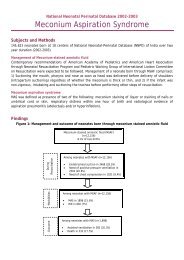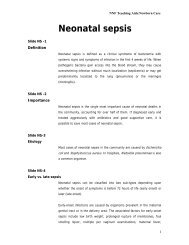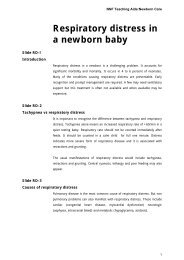Hypoglycemia in the newborn period - New Born Baby
Hypoglycemia in the newborn period - New Born Baby
Hypoglycemia in the newborn period - New Born Baby
You also want an ePaper? Increase the reach of your titles
YUMPU automatically turns print PDFs into web optimized ePapers that Google loves.
AIIMS- NICU protocols updated 2007<br />
Table 3: Management plan of babies with asymptomatic hypoglycemia on screen<strong>in</strong>g<br />
Blood sugar 20-40 mg/dL Trial of oral feeds/fortified feeds (prepared by add<strong>in</strong>g 5g sugar<br />
<strong>in</strong> 100ml or by constitut<strong>in</strong>g formula <strong>in</strong> 5% dextrose <strong>in</strong>stead of<br />
water) and repeat test after 1 hour. If repeat blood sugars are<br />
above 40 mg/dL, 2 nd hourly feed is ensured with 6 hrly<br />
monitor<strong>in</strong>g for 48 hrs<br />
If repeat blood sugars are < 40mg/dL than IV fluids are started<br />
and <strong>the</strong> management is as for symptomatic hypoglycemia<br />
Blood sugar levels < 20 mg/dL IV fluid are started at 6 mg/kg/m<strong>in</strong> of glucose , <strong>the</strong> fur<strong>the</strong>r<br />
Oral feeds – issues<br />
management is as for symptomatic hypoglycemia<br />
Direct breast-feed<strong>in</strong>g is <strong>the</strong> best option for a trial of an oral feed. If <strong>the</strong> baby is unable to suck,<br />
expressed breast milk may be used. Breast milk promotes ketogenesis (ketoacids are important<br />
alternate sources for <strong>the</strong> bra<strong>in</strong> along with less important pyruvate, free fatty acids, glycerol,<br />
am<strong>in</strong>o acids). If breast milk is not available, <strong>the</strong>n formula feed may be given <strong>in</strong> at-risk neonates.<br />
If oral feeds are contra<strong>in</strong>dicated, start glucose <strong>in</strong>fusion.<br />
Some of <strong>the</strong> randomized cl<strong>in</strong>ical trials <strong>in</strong> SGA 13 and appropriate-for-gestational age 14 <strong>in</strong>fants<br />
found that <strong>the</strong> sugar or sucrose fortified milk (5g sugar per 100 mL milk) raises blood glucose<br />
and prevents hypoglycemia. Such a supplementation may be tried <strong>in</strong> <strong>the</strong> asymptomatic neonates<br />
with blood sugar levels between 20 to 40 mg/dL. However this practice carries a potential to<br />
compromise breast feed<strong>in</strong>g rates.<br />
Symptomatic babies should be treated with IV fluids<br />
Management of symptomatic hypoglycemia<br />
For symptomatic hypoglycemia <strong>in</strong>clud<strong>in</strong>g seizures, a bolus of 2 mL/kg of 10% dextrose should<br />
be given. This m<strong>in</strong>i-bolus helps to rapidly achieve <strong>the</strong> steady state levels of blood glucose. 15<br />
Immediately after <strong>the</strong> bolus, a glucose <strong>in</strong>fusion at an <strong>in</strong>itial rate of 6 mg/kg/m<strong>in</strong> should be<br />
started. Check blood sugar after 1 h and <strong>the</strong>n 6 hourly , if blood sugar is >50 mg/dL.<br />
Repeat subsequent hypoglycemic episodes may be treated by <strong>in</strong>creas<strong>in</strong>g <strong>the</strong> glucose <strong>in</strong>fusion rate<br />
by 2 mg/kg/m<strong>in</strong> till a maximum of 12 mg/kg/m<strong>in</strong>. If two or more consecutive values are > 50<br />
Downloaded from www.<strong>newborn</strong>whocc.org<br />
7








